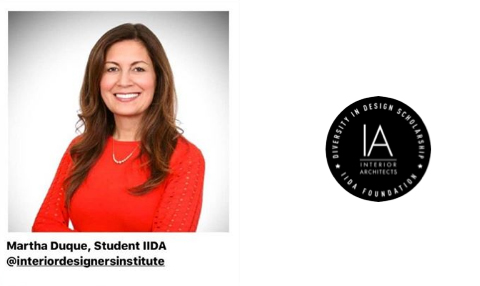Congratulations to Martha Duque, IDI Bachelor of Arts Degree in Interior Design Student, 2019 IA Interior Architects Diversity In Design Scholarship Recipient

Deepening Design through Diversity.
By Martha Duque, Student IIDA.
With the expansive reach of technology, creativity inspiration sources have become endless. Traveling to exotic destinations, bustling urban environments, nature’s wonders, and cultural heritage sites, is readily available at your fingertips though your computer screen. But incorporating diversity in design is about a lot more than just sourcing visual inspiration from around the world. It is about understanding how people in different cultures communicate, how they interact, what they value, where their comfort zones are, and how they experience the world. Taking the best of these worlds to create a unique and desirable experience for clients is how we truly enrich and elevate design.
Diversity has become a big plus when it comes to the hiring and selection of employees at the top design firms. The mix of experiences brought to the table by candidates with a global background in a variety of industries, segments and levels is so unique, that it can’t be easily replicated by competitors. It also creates a culture that continually evolves and morphs with new recruits, producing a dynamic work environment that never becomes stale or stagnant. Working in cross-functional and cross-cultural teams not only to brings together best-practice leaders, but it enhances the diversity of the design solutions. These power teams are pushing the boundaries of creativity and bringing a whole new dimension to their designs though the cross- pollination of ideas.
The search for inspiration across seemingly unrelated vertical markets is also a big contributor to design diversity. With the trend towards experience-based interiors, experts are engaging in new creative thinking techniques to promote innovation. The healthcare industry is pulling from the hospitality industry for inspiration, corporate and retail segments are taking elements from the entertainment and leisure industries. Spaces are no longer unidimensional, they go beyond just being functional and aesthetically pleasing to become fun and engaging hubs for social interaction and collaboration, enticing people to stay longer and come back for more.
Technology is also re-shaping the future of design. Some may argue that technology has granted access to so much information that it has made it harder to create truly original designs. But when access to these resources is used to stimulate creativity rather than to copy, the possibilities are infinite. Technology may be considered disruptive in the development of social connections, distancing us from those closest to
us, but it has also brought those furthest away from us much closer, facilitating the exchange of ideas and strengthening bonds with colleagues and business partners across the globe. As more design tools become available to the design community, not only can we easily capture, store, and disseminate knowledge, but we can use that knowledge and combine it with artificial intelligence to generate innovative new spaces.
Those at the leading edge of architectural and interior design are taking advantage of technology advances, artificial intelligence, employee diversity, and segment cross-pollination to get ahead of the pack, rewrite the norms and reshape the future of design.

